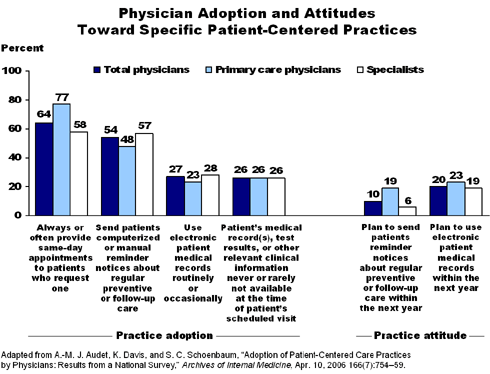New York City, NY, April 10, 2006—Physicians favor "patient-centered care" but only 22 percent scored high in incorporating such techniques into their day-to-day practices, a new Commonwealth Fund-supported study shows. According to the research published in today's Archives of Internal Medicine, physicians have made strides in the areas of access to care and management of referrals, but still have a long way to go when it comes to information technology, team-based care, and collecting feedback from patients.
In "Adoption of Patient-Centered Care Practices by Physicians: Results from a National Survey," Commonwealth Fund researchers Anne-Marie Audet, M.D., Karen Davis, Ph.D., and Stephen C. Schoenbaum, M.D. found that a majority of physicians were able to implement some patient-centered care practices. About two-thirds (64%) of all physicians (including primary care physicians and specialists) said they were always or often able to provide same-day appointments to patients who requested them, and two-thirds (65%) said they always or often received timely information about the results of patient referrals. A wide majority of primary care physicians (PCPs) express support for elements of patient-centered care: 87% support improved teamwork among physicians and medical care professionals to improve quality of care for patients, and 83% agree that patients should have access to their own medical records.

However, in other areas there were shortfalls:
- Just 16 percent of PCPs communicate with patients via e-mail, and only 12 percent said they plan to use e-mail to communicate with patients about care in the next year.
- About three-quarters (74%) of PCPs said they had observed some problems with availability of patients' medical records, test results, or other relevant information at the time of a scheduled visit.
- Slightly less than half (48%) of PCPs send patients reminder notices about regular preventive or follow-up care.
- Fewer than one-quarter (23%) of PCPs use electronic medical records.
- Only one-quarter (25%) of all physicians receive data on quality of care based on patient surveys or experiences with their care.
- Only about one-fifth (19%) of all physicians have access to data about physicians' quality of care when making referrals. A majority (71%) agree that having better information when making referrals would improve quality of care for patients.
- However, only slightly more than half (55%) of all physicians think patients should probably or definitely have quality of care data about their own physicians.
"Patient-centered care practices are not just about having a good 'bedside manner,'" said Fund President Karen Davis. "Practices such as good physician-patient communication and publicly available quality information are necessary to provide health care that is well-coordinated, efficient, and effective."
Survey results point to a gap between attitudes and behavior when it comes to patient-centered care. Physicians face significant challenges in adopting patient-centered care practices, despite the fact that they are supportive of them. According to the survey, 63% of physicians reported that training and knowledge were barriers to the implementation of a number of patient-centered care practices and 84% cited cost as a barrier. Only about one-quarter (27%) said they were rewarded based on patient survey data. The authors conclude that "education, professional technical assistance, and financial incentives might facilitate broader adoption of patient-centered care practices."
"We know that patient-centered care improves the quality of health care and the survey findings clearly tell us that physicians are moving in the right direction, but they need adequate support," said Audet, vice president for quality improvement at the Fund. "The challenge will be to get them the technical assistance and financial incentives that will allow them to integrate these key patient-centered care practices."
The nationally representative survey of more than 1800 physicians focused on 11 specific patient-centered care practices: same-day appointments; e-mail with patients; reminder notices for preventive or follow-up care; registries of patients with chronic conditions; patient medication lists; electronic medical records; information from referral physicians promptly available; medical records/test results readily available when needed; patient survey data fed back to practice; patient ratings of care affect compensation; information on quality of care of referral physicians available. The researchers rated physicians' patient-centered practice scores as low, medium, or high based on how many of these 11 patient-centered care practices they had adopted. One-fifth (20%) scored in the low range (0-2 practices adopted), 58% in the medium range (3-5) and 22% in the high range (6-11).
Physicians in practices of 50 or more were more likely to adopt patient-centered practices than solo physicians. One-third (33%) of physicians in large practices scored high in patient-centered care, compared with 14 percent of physicians in solo practices.
The authors conclude that "with the right knowledge, tools, and practice environment, and in partnership with their patients, physicians should be well positioned to provide the services and care that their patients want and have a right to expect."
Methodology
Researchers used data from the 2003 Commonwealth Fund National Survey of Physicians and Quality of Care. 1837 physicians responded to the self-administered questionnaire—a response rate of 52.8%. All physicians in the sample were involved in direct care of adults and had been in practice for at least 3 years post residency.


